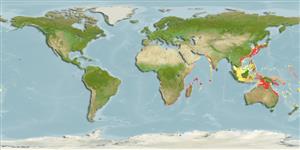>
Lophiiformes (Anglerfishes) >
Ogcocephalidae (Batfishes)
Etymology: Halieutaea: Greek, halieutis = fisher (Ref. 45335).
Eponymy: Frederick William FitzSimons (1870–1951) was an Irish-born South African naturalist and herpetologist particularly interested in snakes and their venom. [...] (Ref. 128868), visit book page.
More on authors: Gilchrist & Thompson.
Environment: milieu / climate zone / depth range / distribution range
Ökologie
seewasser demersal; tiefenbereich 20 - 120 m (Ref. 6612). Subtropical
Indo-West Pacific: off South Africa, Madagascar, New Caledonia, Salomon Is., the Philippines, Taiwan and Japan.
Size / Gewicht / Alter
Maturity: Lm ? range ? - ? cm
Max length : 30.0 cm TL Männchen/unbestimmt; (Ref. 6612)
Rückenflossenweichstrahlen (insgesamt) : 4 - 5; Afterflossenstacheln: 0; Afterflossenweichstrahlen: 4. Dorsally red ventrally (Ref. 6612).
Life cycle and mating behavior
Geschlechtsreife | Fortpflanzung | Ablaichen | Eier | Fecundity | Larven
Bradbury, M.G., 1986. Ogcocephalidae. p. 370-373. In M.M. Smith and P.C. Heemstra (eds.) Smiths' sea fishes. Springer-Verlag, Berlin. (Ref. 6612)
IUCN Rote Liste Status (Ref. 130435: Version 2024-2)
Bedrohung für Menschen
Harmless
Nutzung durch Menschen
Tools
Zusatzinformationen
Download XML
Internet Quellen
Estimates based on models
Preferred temperature (Ref.
123201): 20.8 - 28.1, mean 26.9 °C (based on 191 cells).
Phylogenetic diversity index (Ref.
82804): PD
50 = 0.5020 [Uniqueness, from 0.5 = low to 2.0 = high].
Bayesian length-weight: a=0.02344 (0.00968 - 0.05678), b=2.94 (2.73 - 3.15), in cm total length, based on LWR estimates for this (Sub)family-body shape (Ref.
93245).
Trophic level (Ref.
69278): 3.4 ±0.6 se; based on size and trophs of closest relatives
Widerstandsfähigkeit (Ref.
120179): niedrig, Verdopplung der Population dauert 4,5 - 14 Jahre. (Preliminary K or Fecundity.).
Fishing Vulnerability (Ref.
59153): Low vulnerability (20 of 100).
